Comprehensive Study on the 143 A.D. West Gangu Earthquake in the West Qinling Area, Northeastern Margin of Tibetan Plateau
Abstract
1. Introduction

2. Geological Setting
3. Data and Methods
4. Investigation of the Surface Rupture Zone
4.1. Surface Rupture Zone East of Pangjiawan Village (Site ①)
4.2. Surface Rupture Zone Southwest of Baishitou Village (Site ③)
4.3. Surface Rupture Zone South of Heiniuping–Yanjiaping Village (Site ⑤–⑥)
4.4. Surface Rupture Zone East of Qingyawan (Site ⑦)
5. Distribution Characteristics of Landslides
6. Discussion
6.1. Coseismic Displacements and Magnitude
6.2. Length of Surface Rupture Zone
6.3. Distribution of Coseismic Landslides
6.4. Historical Records
6.5. Risk Assessment of Future Earthquakes
7. Conclusions
Author Contributions
Funding
Data Availability Statement
Acknowledgments
Conflicts of Interest
References
- Hou, K.; Wang, Q. Fundamental characteristics of Gulang Ms 8 Earthquake in 1927. Earthq. Res. Plateau 1999, 11, 12–18. (In Chinese) [Google Scholar]
- Yuan, D.; Lei, Z.; Yang, Q.; Wang, A.; Xie, H.; Su, Q. Seismic disaster features of the 1879 southern Wudu M 8 earthquake in Gansu Province. J. Lanzhou Univ. Nat. Sci. 2014, 50, 611–621. (In Chinese) [Google Scholar]
- Yang, X.; Feng, X.; Huang, X.; Song, F.; Li, G.; Chen, X.; Zhang, L.; Huang, W. The Late Quaternary activity characteristics of the Lixian-Luojiabu fault: A discussion on the seismogenic mechanism of the Lixian M 8 earthquake in 1654. Chin. J. Geophys. 2015, 58, 504–519. (In Chinese) [Google Scholar]
- Tapponnier, P.; Xu, Z.; Roger, E.; Meyer, B.; Arnaud, N.; Wittlinger, G.; Yang, J. Oblique stepwise rise and growth of the Tibetan Plateau. Science 2001, 294, 1671–1677. [Google Scholar] [CrossRef] [PubMed]
- Deng, Q.; Zhang, P.; Ran, Y.; Yang, X.; Min, W.; Chu, Q. Basic characteristics of active tectonics of China. Sci. China Ser. D 2002, 46, 356–372. (In Chinese) [Google Scholar] [CrossRef]
- Zhang, P.; Deng, Q.; Zhang, G.; Ma, J.; Gan, W.; Min, W.; Mao, F.; Wang, Q. Strong earthquake activity and active blocks in Chinese Mainland. Sci. China Ser. D 2003, S1, 12–20. (In Chinese) [Google Scholar]
- Gu, G.; Lin, T.; Shi, Z.; Li, Q.; Wu, H.; Lu, S.; Yang, Y.; Chen, H.; Wang, S. China Earthquake Catalogue (1831 BC–1969 AD); Science Press: Beijing, China, 1983. (In Chinese) [Google Scholar]
- Lanzhou Institude of Seismology; SSB. Catalogue of Strong Earthquakes in the Four Provinces (Region) of Shaanxi, Gansu, Ningxia and Qinghai (1177 BC–1982 AD); Shaanxi Scientific and Tectnological Press: Xi’an, China, 1985; p. 6. (In Chinese) [Google Scholar]
- Department of Earthquake Disaster Prevention; SSB. Catalogue of Chinese Strong Historical Earthquakes; Seicmological Press: Beijing, China, 1995; pp. 7–8. (In Chinese) [Google Scholar]
- Yuan, D.; Lei, Z.; Ge, W.; Liu, W.; Liu, B.; Zhang, J. A New Opinion abour the West of Gangu M 7.0 Earthquake in 143 A.D. in Gansu Province. Northwestern Seismol. J. 2007, 29, 58–63. (In Chinese) [Google Scholar]
- Wang, A.; Yuan, D.; Zhang, B.; Wu, Z.; Shao, Y.; Wang, J. Seismic hazard and harmfulness in the north margin of western Qinling Fault zone. City Disaster Reduct. 2018, 4, 48–54. (In Chinese) [Google Scholar]
- USGS. SRTMGL1 v003. 2000. Available online: https://lpdaac.usgs.gov/products/srtmgl1v003 (accessed on 5 February 2024).
- Deng, Q.; Ran, Y.; Yang, X.; Min, W.; Chu, Q. Map of Active Tectonics in China; Seismological Press: Beijing, China, 2007; Volume 2. (In Chinese) [Google Scholar]
- Xu, X.; Ran, Y.; Yang, X.; Zhang, S.; Yu, G.; Zhou, B.; Li, F.; Ma, B.; Chen, G.; Ran, Y. Seismotectonic Map of China and Adjacent Areas; Seismological Press: Beijing, China, 2016; Volume 1. (In Chinese) [Google Scholar]
- National Earthquake Data Center. Catalogue of Historical Earthquakes in China; National Earthquake Data Center: Beijing, China, 2023. (In Chinese) [Google Scholar]
- Shao, Y.; Yuan, D.; Wang, A.; Liang, M.; Liu, K.; Feng, J. The segmentation of rupture and estimate of earthquake risk along the north margin of western Qinling Fault zone. Seismol. Geol. 2011, 33, 79–90. (In Chinese) [Google Scholar]
- Li, C.; Zhang, P.; Zhang, J.; Yuan, D.; Wang, Z. Lare-Quaternary activity and sliprate of the western Qinling Fault zone at Huangxianggou. Quat. Sci. 2007, 27, 54–63. (In Chinese) [Google Scholar]
- Wu, Z. Study on New Features of Tectonic Activity and Seismic Hazard at the Middle-Eastern Segment of Western Qinling Fault Zone. Master’s Thesis, Lanzhou Institute of Seismology, CEA, Lanzhou, China, 2016. (In Chinese). [Google Scholar]
- Chen, P.; Lin, A. Tectonic topography and Late Pleistocene activity of the West Qinling Fault, northeastern Tibetan Plateau. J. Asian Earth Sci. 2019, 176, 68–78. [Google Scholar] [CrossRef]
- Lei, Z.; Yuan, D.; Ge, W.; He, W.; Liu, X. Textual research in the Tianshui M 7 Earthquake in 734 AD and analysis of its causative structure. Seismol. Geol. 2007, 29, 51–62. (In Chinese) [Google Scholar]
- Zhang, B.; He, W.; Fang, L.; Pang, W.; Zhao, Z.; Liu, X. Surveys on Surface Rupture Phenomena of Gansu Kangle M 6¾ Earthquake in 1936. J. Seismol. Res. 2015, 38, 262–271+333. (In Chinese) [Google Scholar]
- Yuan, D.; Lei, Z.; Wu, Z.; Feng, J. Textual research of Longxi Earthquake in 47 BC in Gangu province and analysis of its causative structure. Seismol. Geol. 2017, 39, 819–836. (In Chinese) [Google Scholar]
- Xu, Y.; Zeng, J.; Allen, M.; Du, P. Understanding historical earthquakes by mapping coseismic landslides in the Loess Plateau, northwest China. Earth Surf. Process. Landf. 2022, 47, 2266–2282. [Google Scholar] [CrossRef]
- Li, C.; Zhang, P.; Yuan, D.; Wang, Z.; Zhang, J. Late-Quaternary horizontal displacement and its associated micro-geomorphology of the western Qinling Fault zone at Huangxianggou. Seismol. Geol. 2006, 28, 391–404. (In Chinese) [Google Scholar]
- Wei, Z.; Arrowsmith, R.; He, H.; Gao, W. Accuracy analysis of terrain point cloud acquired by “Structure from Motion” using arial photos. Seismol. Geol. 2015, 37, 636–648. (In Chinese) [Google Scholar]
- Keefer, D. Landslides caused by earthquakes. Geol. Soc. Am. Bull. 1984, 95, 406–421. Available online: https://pubs.usgs.gov/publication/70014049 (accessed on 10 February 2024). [CrossRef]
- Rodriguez, C.; Bommer, J.; Chandler, R. Earthquake-induced landslides: 1980–1997. Soil Dyn. Earthq. Eng. 1999, 18, 325–346. [Google Scholar] [CrossRef]
- Xu, C.; Xu, X.; Shyu, B.; Zheng, W.; Min, W. Landslides triggered by the 22 July 2013 Minxian-Zhangxian, China, Mw 5.9 earthquake: Inventory compiling and spatial distribution analysis. J. Asian Earth Sci. 2014, 92, 125–142. [Google Scholar] [CrossRef]
- Fukuoka, H.; Sassa, K.; Scarascia-Mugnozza, G. Distribution of Landslides Triggered by the 1995 Hyogo-ken Nanbu Earthquake and Long Runout Mechanism of the Takarazuka Golf Course Landslide. J. Phys. Earth 1997, 45, 83–90. [Google Scholar] [CrossRef]
- Xu, C.; Xu, X.; Yu, G. Landslides triggered by slipping-fault-generated earthquake on a plateau: An example of the 14 April 2010, Ms 7.1, Yushu, China earthquake. Landslides 2013, 10, 421–431. [Google Scholar] [CrossRef]
- Dai, C.; Xu, C.; Yao, X.; Xu, L.; Tu, X.; Gong, Q. Spatial distribution of landslides triggered by the 2008 Ms 8.0 Wenchuan earthquake, China. J. Asian Earth Sci. 2011, 40, 883–895. [Google Scholar] [CrossRef]
- Gorum, T.; Western, C.; Korup, O.; Meijde, M.; Fan, X.; Meer, F. Complex rupture mechanism and topography control symmetry of mass-wasting pattern, 2010 Haiti earthquake. Geomorphology 2013, 184, 127–138. [Google Scholar] [CrossRef]
- Wells, D.; Coppersmith, K. New Empirical Relationships among Magnitude, Rupture Length, Rupture Width, Rupture Area, and Surface Displacement. Bull. Seismol. Soc. Am. 1994, 84, 974–1002. [Google Scholar] [CrossRef]
- Yeats, R.; Sieh, K.; Allen, C. The Geology of Earthquakes; Oxford University Press: New York, NY, USA, 1997; pp. 1–568. [Google Scholar]
- Cheng, J.; Rong, Y.; Magistrale, H.; Chen, G.; Xu, X. An Mw-Based Historical Earthquake Catalog for Mainland China. Bull. Seismol. Soc. Am. 2017, 107, 2490–2500. [Google Scholar] [CrossRef]
- Yuan, D.; Xie, H.; Su, R.; Li, Z.; Wen, Y.; Si, G.; Xue, S.; Chen, G.; Liu, B.; Liang, S.; et al. Characteristics of co-seismic surface rupture zone of Menyuan Ms 6.9 earthquake in Qinhai Province on 8 January 2022 and seismogenic mechanism. Chin. J. Geophys. 2023, 66, 229–244. (In Chinese) [Google Scholar]
- Wen, Y.; Yuan, D.; Xie, H.; Su, R.; Su, Q.; Li, Z.; Sun, H.; Si, G.; Yu, J.; Chen, Y.; et al. Typical Fine Structure and Seismogenic Mechanism Analysis of the Surface Rupture of the 2022 Menyuan Mw 6.7 Earthquake. Remote Sens. 2023, 15, 4375. [Google Scholar] [CrossRef]
- Harp, E.; Jibson, R.; Dart, R. The Effect of Complex Fault Rupture on the Distribution of Landslides Triggered by the 12 January 2010, Haiti Earthquake. Landslide Sci. Pract. 2013, 5, 157–161. [Google Scholar] [CrossRef]
- Xu, C.; Xu, X.; Yao, X.; Dai, F. Three (nearly) complete inventories of landslides triggered by the 12 May 2008 Wenchuan Mw 7.9 earthquake of China and their spatial distribution statistical analysis. Landslides 2014, 11, 441–461. [Google Scholar] [CrossRef]
- Wang, L.; Yuan, Z.; Shi, Y.; Sun, C. Study on the methods and indexes of zonation for seismic losessal disasters. J. Nat. Disasters 1999, 8, 87–92. (In Chinese) [Google Scholar]
- Cai, S.; Wang, L.; Yuan, Z. A preliminary study on the seismic landslide distance in the Shaanxi-Gansu-Ningxia-Shanxi loess region. Northwestern Seismol. J. 1998, 20, 75–82. (In Chinese) [Google Scholar]
- Han, Z.; Xiang, H.; Guo, S. Primary study on active features of Fenghuangshan-Tianshui fault, West Qinling north boundary fault zone since the late of Late-pleistocene. Acta Seismol. Sin. 2001, 23, 217–220. (In Chinese) [Google Scholar]
- Wang, W.; Yuan, D.; Lei, Z.; Zhang, B. Textual Research on the 1765 Zhuoni-Kangle Earthquake in Gansu Province and Its Causative Structure. China Earthq. Eng. J. 2020, 42, 714–720+758. (In Chinese) [Google Scholar]


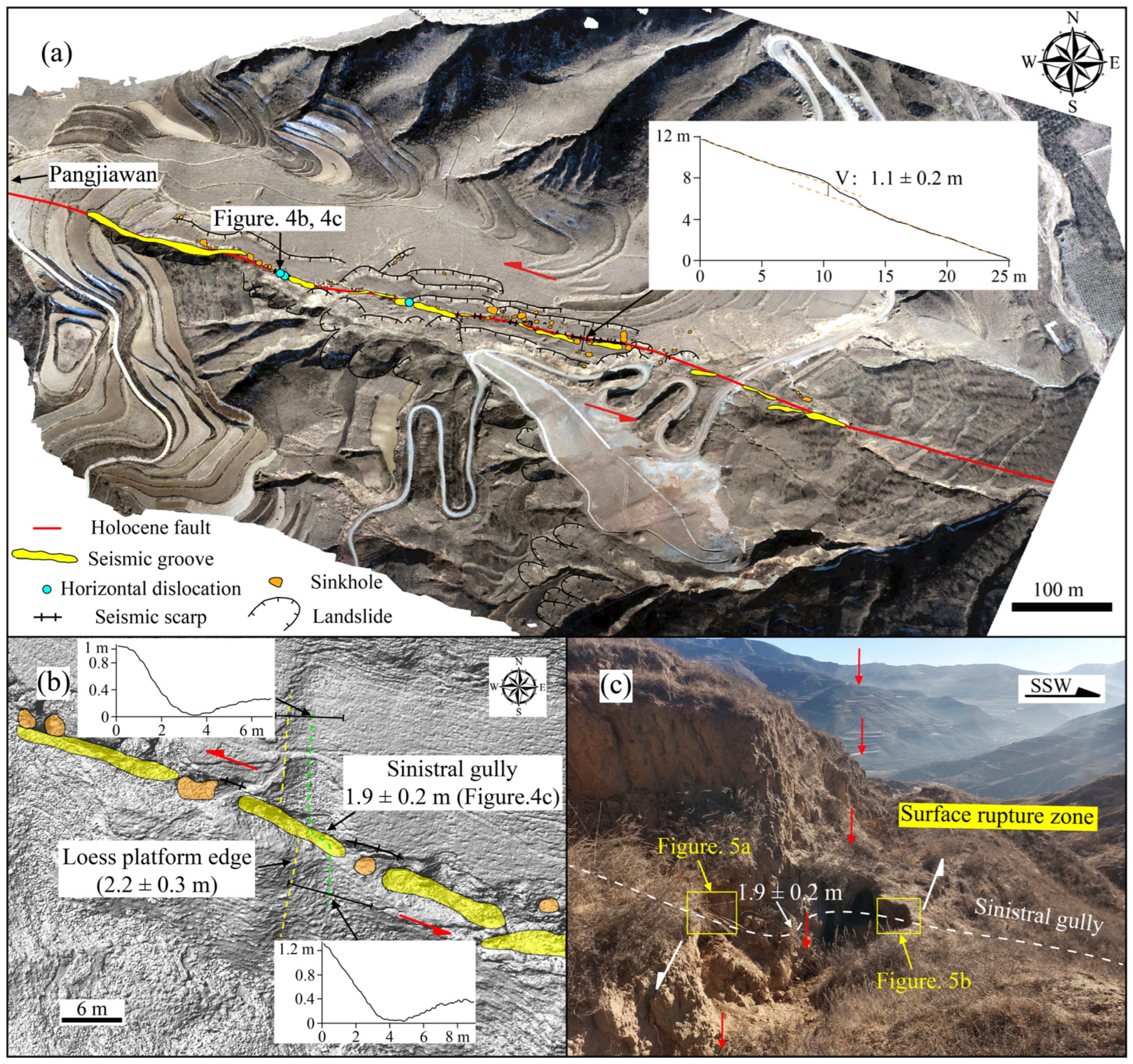


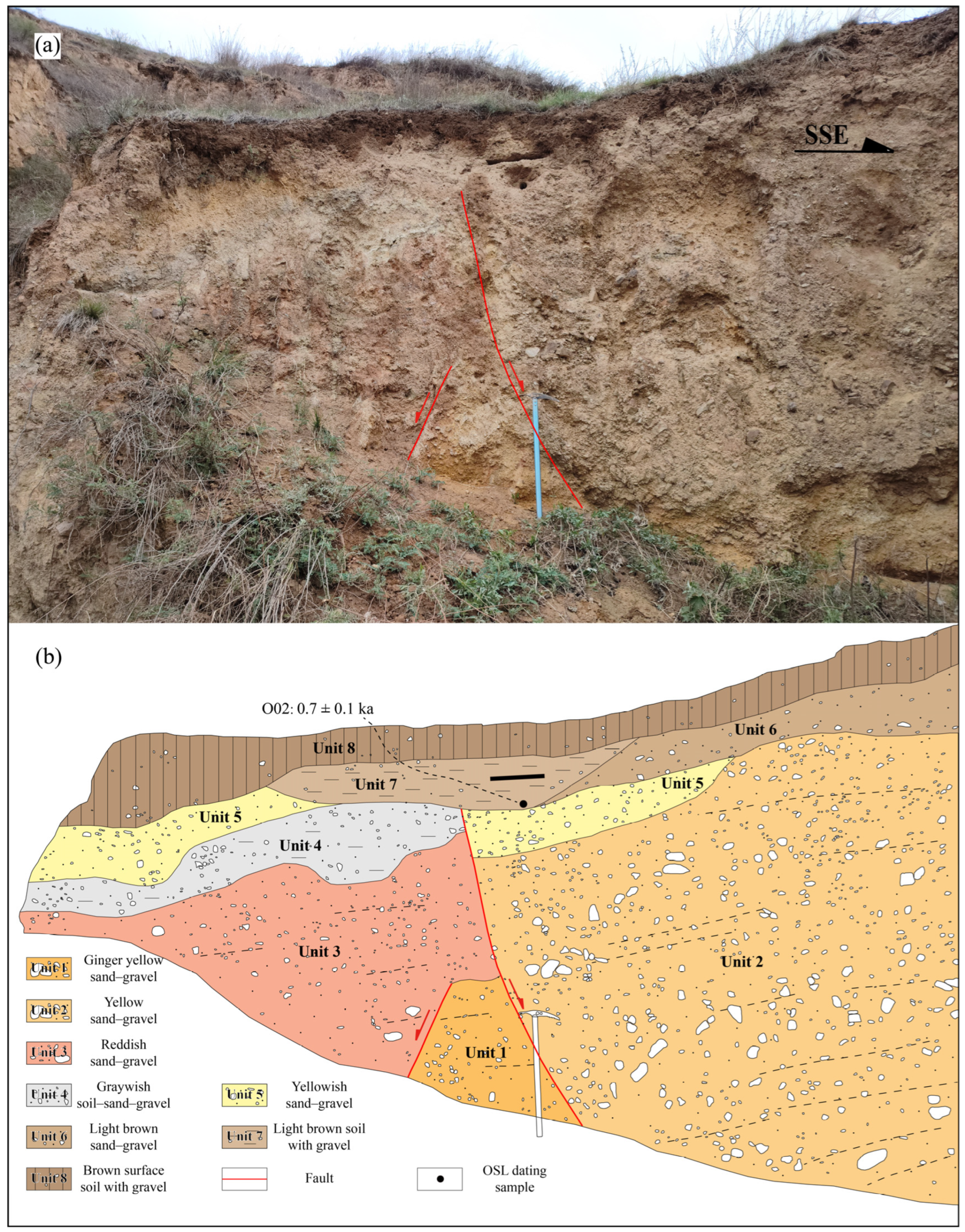
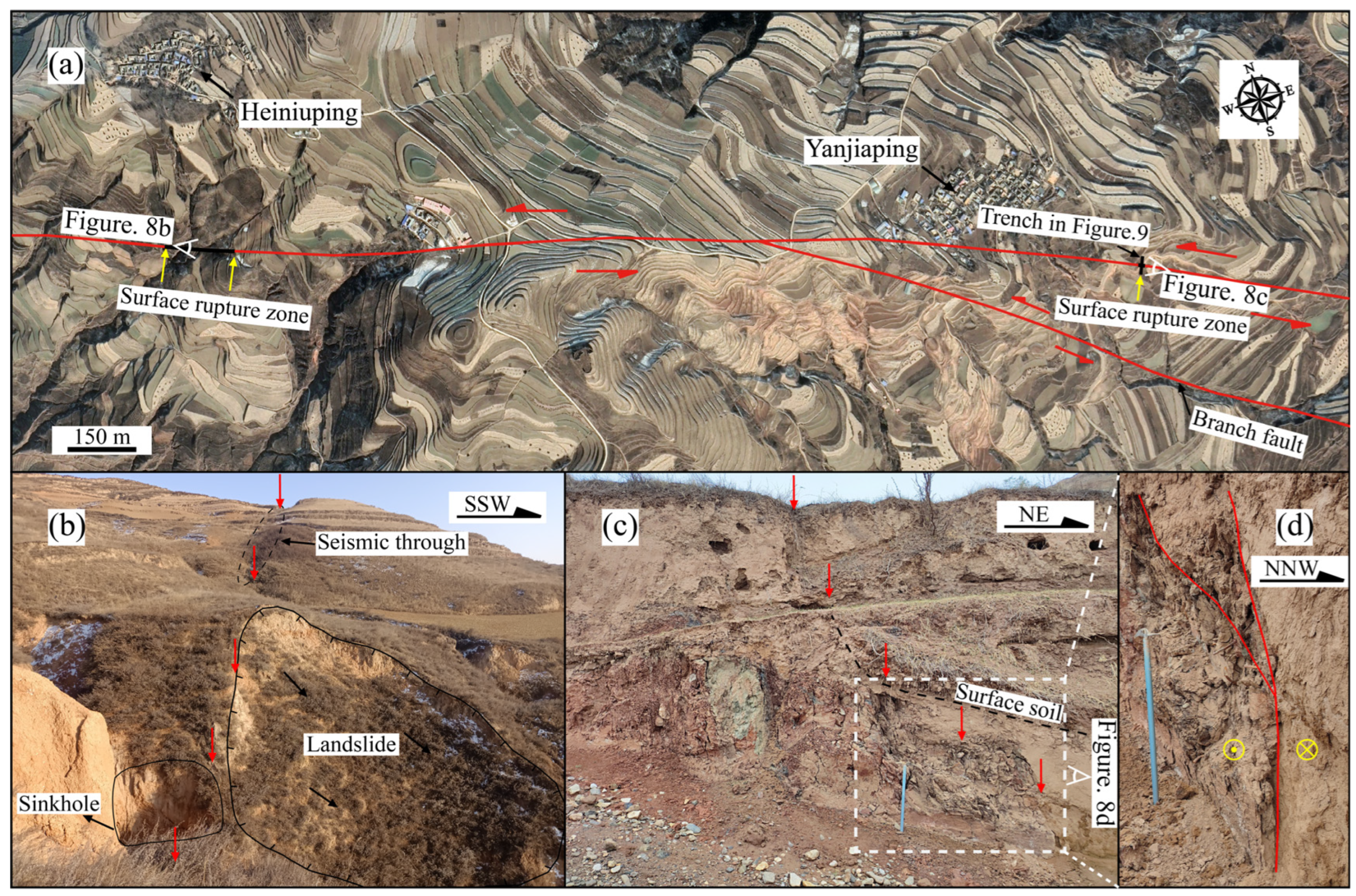
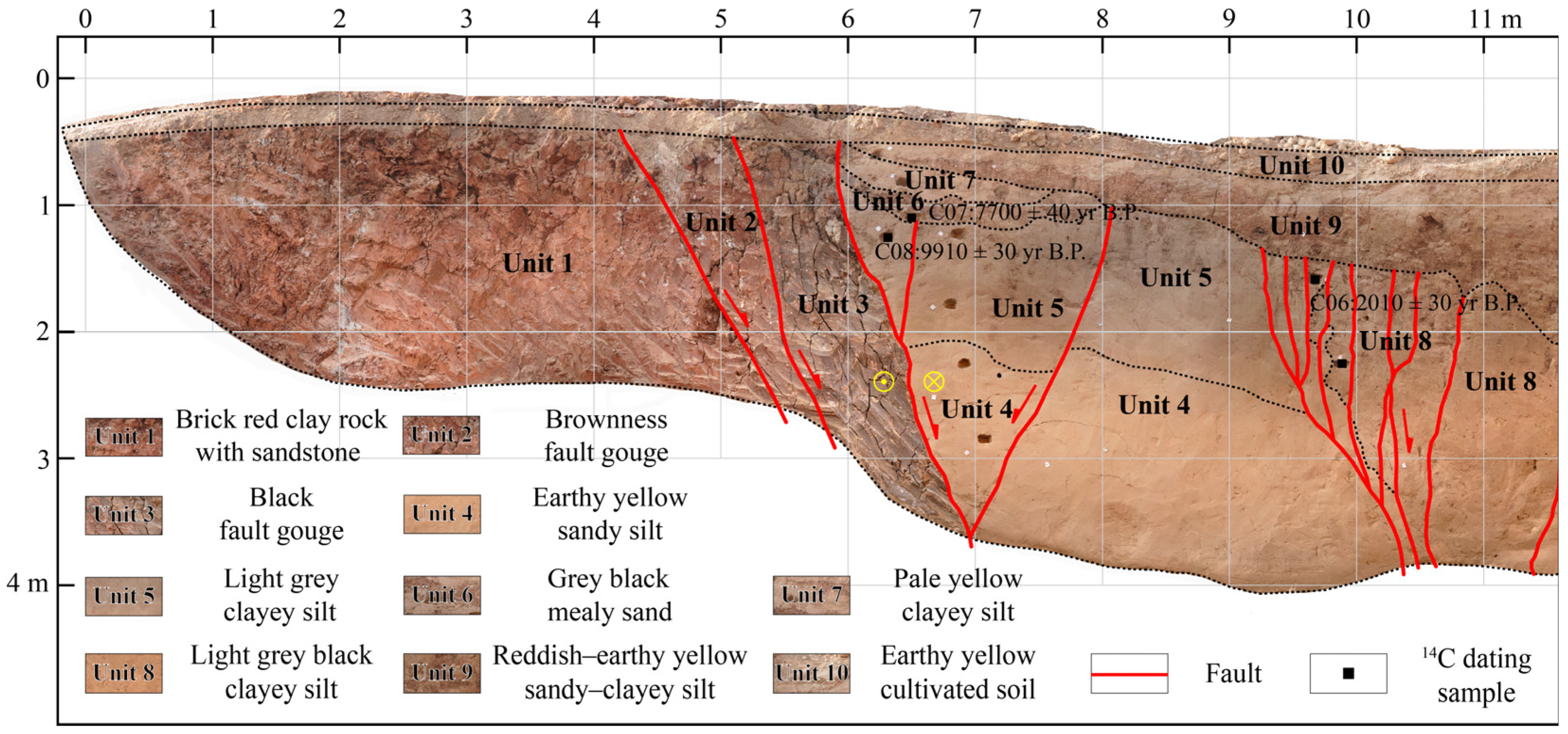

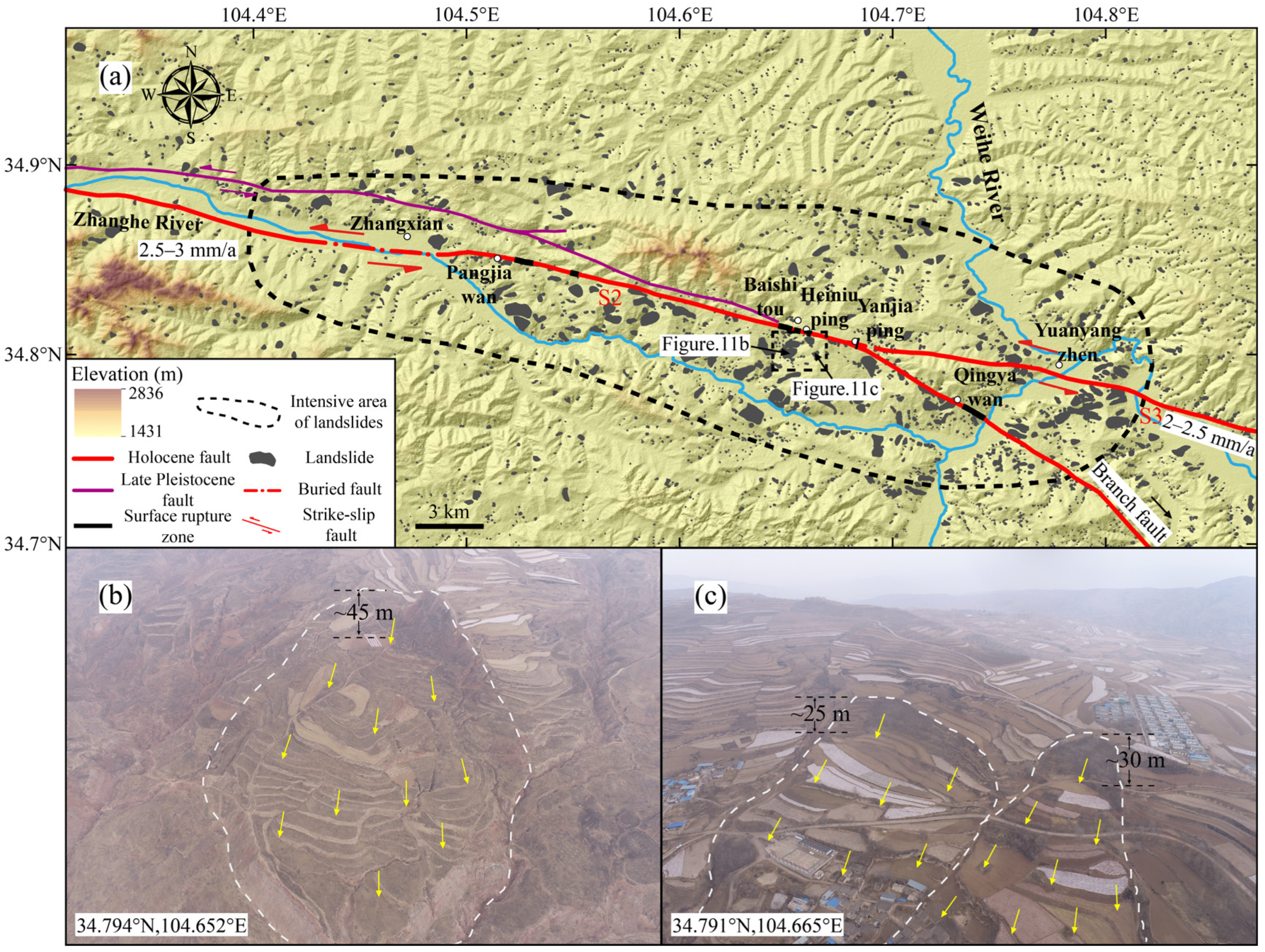
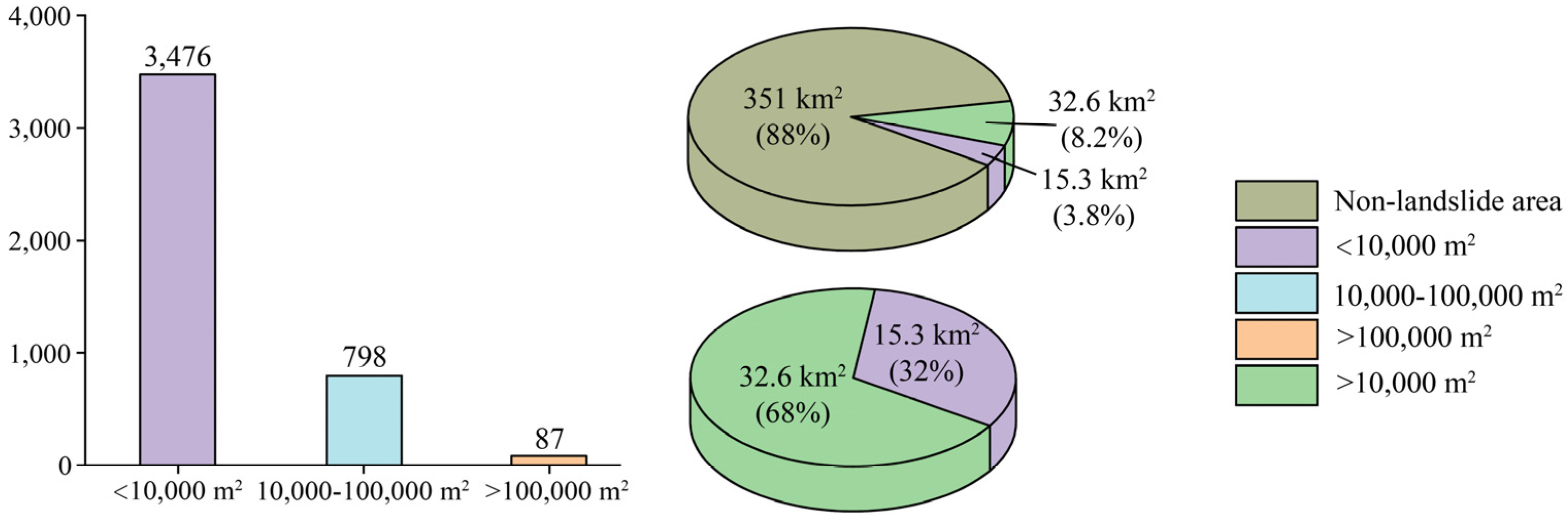


| Sample | Beta ID | Radiocarbon Age (yr B.P.) | Percent Modern Carbon (yr pMC) | Calibrated Age (B.C./A.D.) | Description |
|---|---|---|---|---|---|
| C01 | 616,397 | 101.63 ± 0.38 | A.D. 1954–1956 | Organic soil | |
| C02 | 631,417 | 2280 ± 30 | B.C. 401–351 | Organic soil | |
| C03 | 616,398 | 3960 ± 30 | B.C. 2502–2400 | Organic soil | |
| C04 | 616,395 | 2860 ± 30 | B.C. 1122–927 | Organic soil | |
| C05 | 616,396 | 4230 ± 30 | B.C. 2909–2852 | Organic soil | |
| C06 | 455,321 | 2010 ± 30 | B.C. 61-A.D.65 | Organic soil | |
| C07 | 455,315 | 7700 ± 40 | B.C. 6612–6461 | Organic soil | |
| C08 | 455,317 | 9910 ± 30 | B.C. 9415–9291 | Organic soil |
| Sample ID | Mineral Type | Depth (m) | K (%) | Th (ppm) | U (ppm) | Dose Rate (Gy/ka) | De (Gy) | Age (ka) | Description |
|---|---|---|---|---|---|---|---|---|---|
| O01 | Kf | 1.1 | 1.94 ± 0.08 | 11.49 ± 0.46 | 3.00 ± 0.12 | 3.6 ± 0.09 | 64.7 ± 2.6 | 18.0 ± 0.9 | Loess |
| O02 | Qz | 0.5 | 3.60 ± 0.09 | 8.90 ± 0.36 | 2.20 ± 0.09 | 3.4 ± 0.10 | 2.3 ± 0.5 | 0.7 ± 0.1 | Soil with gravel |
| Number of Rupture Zone | Longitude (°E) | Latitude (°N) | Horizontal Displacement (m) | Vertical Displacement (m) | Geomorphic Marker |
|---|---|---|---|---|---|
| ① | 104.5243 | 34.8372 | 2.2 ± 0.3 | Loess platform edge | |
| ① | 104.5244 | 34.8372 | 1.9 ± 0.2 | Sinistral gully | |
| ① | 104.5257 | 34.8369 | 2.2 ± 0.5 | Loess platform edge | |
| ① | 104.5276 | 34.8365 | 1.1 ± 0.2 | Loess platform scarp | |
| ③ | 104.6505 | 34.8054 | 2.8 ± 0.5 | Loess platform edge | |
| ③ | 104.6506 | 34.8054 | 0.8 ± 0.2 | Loess platform scarp | |
| ③ | 104.6510 | 34.8051 | 2.6 ± 0.3 | Sinistral gully | |
| ④ | 104.6544 | 34.8038 | 2.3 ± 0.5 | Sinistral gully | |
| ④ | 104.6565 | 34.8034 | 2.0 ± 0.5 | Loess platform edge | |
| ④ | 104.6566 | 34.8034 | 1.9 ± 1.0 | Loess platform edge | |
| ⑤ | 104.6607 | 34.8023 | 2.2 ± 0.5 | Loess platform edge |
| Historical Records | Previous Findings | |||
|---|---|---|---|---|
| Contents | Literature | Earthquake Magnitude | Epicenter | Reference |
| In the first month of the initial year of Jiankang, six seismic events occurred within the Liangzhou Province. From September of the preceding year to April, a cumulative count of 180 seismic events were recorded. These seismic events caused damage to mountains and valleys, inflicted harm upon cities and temples, and led to the detriment of both human lives and material possessions. | 《Wuxingzhi》 | 7 | 105.3°E, 34.7°N | [7] |
| 7 | 105.3°E, 34.7°N | [8] | ||
| In the past year, Liangzhou has experienced a total of 180 earthquakes. In the spring of the first year of Jiankang, on the third day of the first lunar month (February 23, 144 A.D.), the emperor issued a decree stating the following: From September of the previous year, the regions of Longxi, Hanyang, Zhangye, Beidi, Wuwei, and Wudu had experienced 180 earthquakes. The mountains crumble and the earth splits, cities and temples have incurred damage, and human lives have been lost. Due to the occurrence of rebellions by foreign tribes, the imposition of high taxes, and the presence of grievances originating from both inside and outside the court, I can only experience feelings of guilt and frustration. Therefore, I have dispatched an official to handle this matter, promote blessings, and provide assistance to the people, thereby alleviating their concerns. | 《Shundiji》 | 7 | 104.0°E, 35.0°N | [9] |
| 7¼ | 104.5°E, 34.5°N | [10] | ||
Disclaimer/Publisher’s Note: The statements, opinions and data contained in all publications are solely those of the individual author(s) and contributor(s) and not of MDPI and/or the editor(s). MDPI and/or the editor(s) disclaim responsibility for any injury to people or property resulting from any ideas, methods, instructions or products referred to in the content. |
© 2024 by the authors. Licensee MDPI, Basel, Switzerland. This article is an open access article distributed under the terms and conditions of the Creative Commons Attribution (CC BY) license (https://creativecommons.org/licenses/by/4.0/).
Share and Cite
Su, R.; Yuan, D.; Xie, H.; Wang, A.; Wen, Y.; Yu, J.; Chen, Y.; Li, H.; Sun, H.; Zhang, L. Comprehensive Study on the 143 A.D. West Gangu Earthquake in the West Qinling Area, Northeastern Margin of Tibetan Plateau. Remote Sens. 2024, 16, 2109. https://doi.org/10.3390/rs16122109
Su R, Yuan D, Xie H, Wang A, Wen Y, Yu J, Chen Y, Li H, Sun H, Zhang L. Comprehensive Study on the 143 A.D. West Gangu Earthquake in the West Qinling Area, Northeastern Margin of Tibetan Plateau. Remote Sensing. 2024; 16(12):2109. https://doi.org/10.3390/rs16122109
Chicago/Turabian StyleSu, Ruihuan, Daoyang Yuan, Hong Xie, Aiguo Wang, Yameng Wen, Jinchao Yu, Yanwen Chen, Hongqiang Li, Hao Sun, and Lijun Zhang. 2024. "Comprehensive Study on the 143 A.D. West Gangu Earthquake in the West Qinling Area, Northeastern Margin of Tibetan Plateau" Remote Sensing 16, no. 12: 2109. https://doi.org/10.3390/rs16122109
APA StyleSu, R., Yuan, D., Xie, H., Wang, A., Wen, Y., Yu, J., Chen, Y., Li, H., Sun, H., & Zhang, L. (2024). Comprehensive Study on the 143 A.D. West Gangu Earthquake in the West Qinling Area, Northeastern Margin of Tibetan Plateau. Remote Sensing, 16(12), 2109. https://doi.org/10.3390/rs16122109









